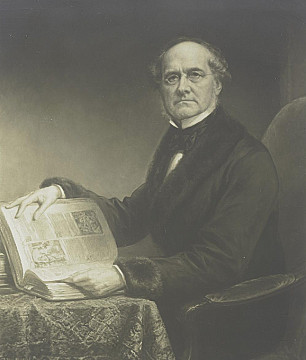James Lenox (1800-1880)
Founder of the New York Public Library
He was born at 175 Pearl Street, New York City, the only son and heir of the immensely wealthy merchant, Robert Lenox. He graduated from Columbia and Princeton in 1821 and having studied law was admitted to the bar. He never practiced and instead went to Europe where he started his passion for collecting rare books. In 1826, he joined his father in his business ventures, trading under the name of Robert Lenox & Son. After his father died in 1839, while keeping a keen eye on his assets, he dedicated himself to books, art, music etc. In 1855, Lenox was estimated to be the third richest man in New York with a combined fortune in excess of $3-million. Two thirds of that fortune was derived from "Lenox Farm" - 30-acres of prime real estate between Fourth and Fifth Avenue that his father had purchased for just under $7,000 in 1818.
In 1870, he established the Lenox Library on Fifth Avenue at a total cost of just over $2 million. Having donated a million dollars worth of books (85,000 in number), bibles, manuscripts, marble busts and statues, mosaics, engravings, and curios, he had a landmark building constructed by Richard Morris Hunt, which cost a further million dollars. The library's collection of Americana and Shakespeariana were unsurpassed in the States and its collection of bibles were considered to be unequalled, even by those housed in the British Museum. In 1895, the Tilden Trust provided the funds to create the New York Public Library which was established by merging the Lenox and Astor Libraries. The Lenox Library was demolished in 1912 and the Frick Collection now stands in its place.
Lenox served as the Library's first President and was succeeded by his nephew, Robert Lenox Kennedy. He was President of the American Bible Society; Vice-President of the American Antiquarian Society; and, a member of the American Philosophical Society. He gave $600,000 to found the Presbyterian Hospital in New York City and made important gifts to Princeton College as well as various churches. He lived at 53 Fifth Avenue and having been spurned by a woman in his youth he never married and became increasingly reclusive as the years rolled by. He left the remainder of his estate to his two surviving sisters (Mary Sheafe and Henrietta) and a long list of various nephews and nieces.
In 1870, he established the Lenox Library on Fifth Avenue at a total cost of just over $2 million. Having donated a million dollars worth of books (85,000 in number), bibles, manuscripts, marble busts and statues, mosaics, engravings, and curios, he had a landmark building constructed by Richard Morris Hunt, which cost a further million dollars. The library's collection of Americana and Shakespeariana were unsurpassed in the States and its collection of bibles were considered to be unequalled, even by those housed in the British Museum. In 1895, the Tilden Trust provided the funds to create the New York Public Library which was established by merging the Lenox and Astor Libraries. The Lenox Library was demolished in 1912 and the Frick Collection now stands in its place.
Lenox served as the Library's first President and was succeeded by his nephew, Robert Lenox Kennedy. He was President of the American Bible Society; Vice-President of the American Antiquarian Society; and, a member of the American Philosophical Society. He gave $600,000 to found the Presbyterian Hospital in New York City and made important gifts to Princeton College as well as various churches. He lived at 53 Fifth Avenue and having been spurned by a woman in his youth he never married and became increasingly reclusive as the years rolled by. He left the remainder of his estate to his two surviving sisters (Mary Sheafe and Henrietta) and a long list of various nephews and nieces.




